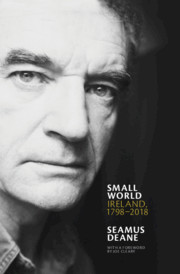Book contents
- Small World
- Small World
- Copyright page
- Dedication
- Contents
- Foreword
- Permissions
- Acknowledgements
- Chapter 1 Swift as Classic
- Chapter 2 Burke in the USA
- Chapter 3 Tone: The Great Nation and the Evil Empire
- Chapter 4 Imperialism and Nationalism
- Chapter 5 Irish National Character 1790–1900
- Chapter 6 Civilians and Barbarians
- Chapter 7 Heroic Styles: The Tradition of an Idea
- Chapter 8 Ulysses: The Exhaustion of Literature and the Literature of Exhaustion
- Chapter 9 Dead Ends: Joyce’s Finest Moments
- Chapter 10 Elizabeth Bowen: Sentenced to Death
- Chapter 11 Elizabeth Bowen: Two Stories in One
- Chapter 12 Mary Lavin: Celibates
- Chapter 13 Emergency Aesthetics
- Chapter 14 Wherever Green is Read
- Chapter 15 The Famous Seamus
- Chapter 16 The End of the World
- Index
Chapter 5 - Irish National Character 1790–1900
Published online by Cambridge University Press: 03 June 2021
- Small World
- Small World
- Copyright page
- Dedication
- Contents
- Foreword
- Permissions
- Acknowledgements
- Chapter 1 Swift as Classic
- Chapter 2 Burke in the USA
- Chapter 3 Tone: The Great Nation and the Evil Empire
- Chapter 4 Imperialism and Nationalism
- Chapter 5 Irish National Character 1790–1900
- Chapter 6 Civilians and Barbarians
- Chapter 7 Heroic Styles: The Tradition of an Idea
- Chapter 8 Ulysses: The Exhaustion of Literature and the Literature of Exhaustion
- Chapter 9 Dead Ends: Joyce’s Finest Moments
- Chapter 10 Elizabeth Bowen: Sentenced to Death
- Chapter 11 Elizabeth Bowen: Two Stories in One
- Chapter 12 Mary Lavin: Celibates
- Chapter 13 Emergency Aesthetics
- Chapter 14 Wherever Green is Read
- Chapter 15 The Famous Seamus
- Chapter 16 The End of the World
- Index
Summary
The aim of this essay is to trace the history of an idea through a series of mutations over a span of about one hundred years. Much of the material is taken from literary sources because it is in these that the potent force of the idea of a national character is most frequently and most memorably realized and it is in the nineteenth century that it becomes a stereotype. The caricaturing of national types was an important instrument of propaganda warfare during and after the French Revolution; the brilliant and savage tradition of Rowlandson and Gillray was carried on through the century, becoming more and more closely bound up with the development of the popular (finally the yellow) press.
- Type
- Chapter
- Information
- Small WorldIreland, 1798–2018, pp. 94 - 121Publisher: Cambridge University PressPrint publication year: 2021

